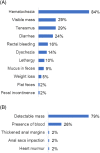Recurrence and survival in dogs with excised colorectal polyps: A retrospective study of 58 cases
- PMID: 37772917
- PMCID: PMC10658478
- DOI: 10.1111/jvim.16876
Recurrence and survival in dogs with excised colorectal polyps: A retrospective study of 58 cases
Abstract
Background: Compared to humans, colorectal polyps are relatively rare in dogs. Epidemiological and prognostic data remain accordingly sparse, although they could help veterinary clinicians in the management of these cases.
Objectives: To report the epidemiological data of dogs with colorectal polyps and identify factors associated with recurrence and survival.
Animals: Fifty-eight client-owned dogs with colorectal polyps admitted to 7 veterinary hospitals (53 dogs from France, 5 dogs from Spain, and 4 dogs from Portugal) were included.
Methods: Retrospective multicentric cohort study. Medical records and long-term outcome of the dogs were reviewed. When available, histological samples were reassessed by 2 board-certified pathologists according to the revised Vienna classification (RVC).
Results: The West Highland White Terrier (WHWT) breed was significantly associated with the presence of colorectal polyps (OR: 20; 95% CI: 7.5-52; P < .001). The overall median time to recurrence was not reached after 2000 days. The overall estimated median survival time was 1640 days. WHWT breed and larger polyps were significantly associated with a shorter time of polyp recurrence after surgical removal (respectively, P = .05 and P = .01).
Conclusions and clinical importance: The probability of recurrence of colorectal polyps in dogs is low, but increased in WHWTs and larger polyps, which might benefit from routine screening after removal. No effective predictors of polyp recurrence and survival were identified using the RVC.
Keywords: cancer; colon; colorectal polyp; dog; outcome; tumor.
© 2023 The Authors. Journal of Veterinary Internal Medicine published by Wiley Periodicals LLC on behalf of American College of Veterinary Internal Medicine.
Conflict of interest statement
Authors declare no conflict of interest.
Figures



References
-
- American Society for Gastrointestinal Endoscopy (ASGE). https://www.asge.org/home/about-asge/newsroom/media-backgrounders-detail.... Accessed March 13, 2021.
-
- Schlemper RJ, Kato Y, Stolte M. Diagnostic criteria for gastrointestinal carcinomas in Japan and Western countries: proposal for a new classification system of gastrointestinal epithelial neoplasia. J Gastroenterol Hepatol. 2000;15(Suppl):G49‐G57. - PubMed
-
- Verseveld M, Barendse RM, Dawson I, Vos EL, de Graaf EJR, Doornebosch PG. Intramucosal carcinoma of the rectum can be safely treated with transanal endoscopic microsurgery; clinical support of the revised Vienna classification. Surg Endosc. 2014;28(11):3210‐3215. - PubMed
MeSH terms
LinkOut - more resources
Full Text Sources
Medical

